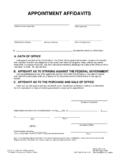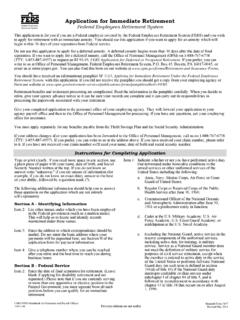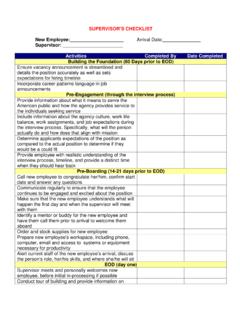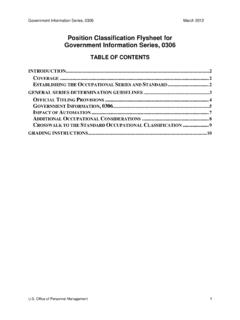Transcription of SUBCHAPTER S8 PAY ADMINISTRATION S8-1 General
1 SUBCHAPTER S8. PAY ADMINISTRATION . S8-1 General a. Introduction. Pay schedules for wage employees are established by the head of the designated lead agency in each wage area. This SUBCHAPTER provides the instructions governing the application of rates of basic pay and premium pay to individual employees. b. Agency responsibility. Nothing in this SUBCHAPTER shall be construed as modifying or diminishing the responsibility of each agency head to consult or negotiate, as appropriate under chapter 71 of title 5, United States Code, with labor organizations holding exclusive recognition or to consult with labor organizations holding consultation rights in connection with the issuance of new or revised regulations on any matter dealt with in this SUBCHAPTER except those on which uniform policy is expressly prescribed therein.
2 Nothing in this SUBCHAPTER shall be construed as modifying or diminishing the responsibility of each activity head within agency regulations concerning this SUBCHAPTER , and as appropriate under chapter 71 of title 5, United States Code, to enter into collective bargaining agreements with labor organizations holding exclusive recognition, relative to changes in personnel policy or practice concerning any matter dealt with in this SUBCHAPTER except those on which uniform policy is expressly prescribed herein. The responsibility to consult or negotiate with recognized labor organizations refers, for example, to many matters where policy is not prescribed herein with respect to, but not limited to, the following items: S8-2a(14) Administrative workweek S8-2a(15) Regularly scheduled administrative workweek 8-2a(16) Basic workweek S8-2a(21) Tour of duty 8-3c Position or appointment change S8-3e(5) Computation of highest previous rate S8-3g(2) Details S8-3j(1) Administrative error.
3 Lower rate S8-4b(8) Callback overtime work S8-2 Definitions In this SUBCHAPTER : (1) Agency has the meaning given that word by section 5342 of title 5, United States Code, and SUBCHAPTER S2, section S2-1, paragraph b, of this operating manual. (2) Scheduled rate of pay means the rate of pay fixed by law or administrative action, including a retained rate of pay and rate on temporary promotion, for the job held by an employee before any deductions and exclusive of additional pay of any kind. (3) Rate of basic pay means scheduled rate of pay plus any night shift or environmental differential.
4 (4) Existing scheduled rate of pay means the scheduled rate of pay received immediately before the effective date of a transfer, reassignment, promotion, change to lower grade, within-grade increase, or revision of a wage schedule. (5) Highest previous rate means the highest scheduled rate of pay previously paid to a person while employed in a job in a branch of the Federal Government (executive, legislative, or judicial), a mixed-ownership corporation ( , the Tennessee Valley Authority) or the government of the District of Columbia, regardless of whether the job was subject to a wage systems schedule.
5 (6) Representative rate means a rate used to determine the nature of the job change (promotion, change to a lower grade, or reassignment) when different kinds of pay schedules are involved, whether in the same or different wage areas. A representative rate is the going rate ( , the rate or step keyed to the prevailing rate determination for example, the established rate on a single-rate schedule, the second rate on a five-rate regular wage schedule, the fourth rate on the General Schedule or a class under the Foreign Service Officer and Foreign Services staff schedules) of the jobs or grades between which the employee is being changed.
6 If the change is between different wage areas, all determinations concerning representative rates are based on the scheduled rates for the jobs or grades involved which are in effect on the date of the change in the local wage area to which the employee is being changed. (7) Promotion means a change in the position of an employee who, while continuously employed: Moves from a position in one grade of a prevailing rate schedule to a position in a higher grade of the same type of prevailing rate schedule, whether in the same or different wage area.
7 Moves from a position under a prevailing rate schedule to a position under a different prevailing rate schedule ( , WG to WL) with a higher representative rate; or Moves from a position not under a prevailing rate schedule to a position with a higher representative rate under a prevailing rate schedule. (8) Change to lower grade means in the position of an employee who, while continuously employed: Moves from a position in one grade of a prevailing rate schedule to a position in a lower grade of the same type prevailing rate schedule, whether in the same or different wage area.
8 Moves from a position under a prevailing rate schedule established under this part to a position under a different prevailing rate schedule ( , WL to WG) with a lower representative rate; or Moves from a position not under a prevailing rate schedule to a position with a lower representative rate under a prevailing rate schedule. (9) Reassignment means a change of an employee while serving continuously in the same agency from one job to another without promotion or change to lower grade. (10) Reemployment means an employment, including reinstatement or another type of appointment, after a break in service of at least 1 full workday.
9 (11) Transfer means a change of an employee, without a break in service of 1 full workday, from the government of the District of Columbia to the Federal Government, or from one branch of the Federal Government (executive, legislative, or judicial) to another, or from one agency to another. (12) New appointment means the first appointment, regardless of tenure, as an employee of the Federal Government. (13) Premium pay means additional compensation for overtime, standby duty, and work performed on a holiday or Sunday. (14) Administrative workweek means a period of 7 consecutive calendar days.
10 Usually an administrative workweek coincides with a calendar week. (15) Regularly scheduled administrative work: For full-time employees means the period within an administrative workweek within which employees are scheduled to be on duty regularly. For part-time employees means the days and hours within an administrative workweek during which these employees are scheduled to be on duty regularly. (16) Basic workweek for full-time employees means the days and hours within an administrative workweek which make up the employee's regularly scheduled 40-hour workweek.

